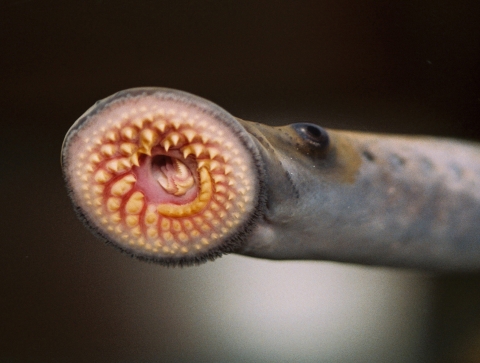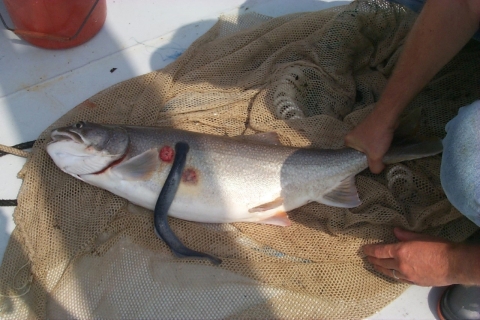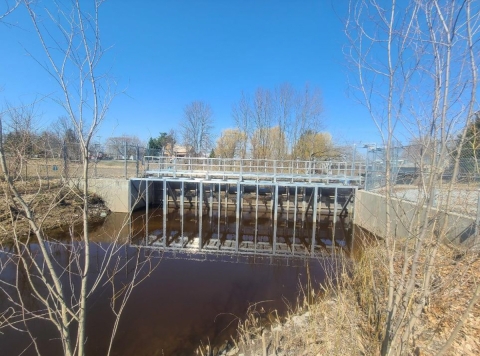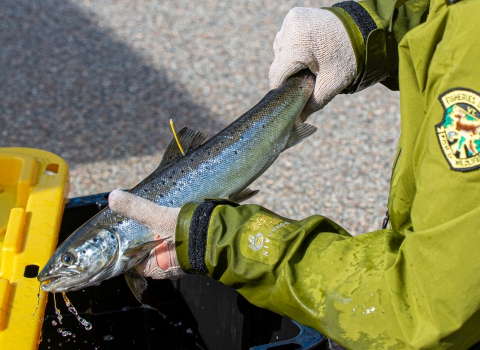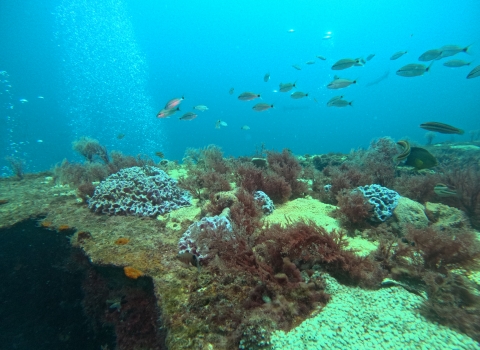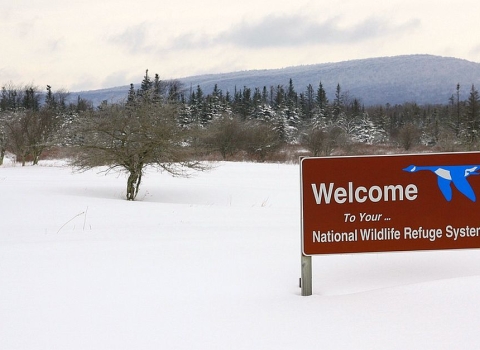It’s a beautiful day on Lake Champlain. Early in the morning, the sun is just barely up, and the lake is quiet. It’s the perfect time to fish. You eagerly cast and wait for a bite. When tension strikes the line, you set your hook and reel in the fish. It’s a lake trout! As you scan its long body, you notice what looks like a smiley face branded into one side. But it's not something to smile about. The trout is missing a chunk of flesh.
The culprit? A prehistoric fish lurking in the lake. This is the work of an invasive sea lamprey.
For more than 30 years, the U.S. Fish and Wildlife Service has worked with Vermont and New York to control this invasive species invasive species
An invasive species is any plant or animal that has spread or been introduced into a new area where they are, or could, cause harm to the environment, economy, or human, animal, or plant health. Their unwelcome presence can destroy ecosystems and cost millions of dollars.
Learn more about invasive species and protect Lake Champlain. Fortunately, sea lamprey woundings are now at an all-time low.
Out of place
Native to the Atlantic Ocean, sea lamprey play an important role in ocean and coastal river ecosystems. But in the wrong waters, where there are few natural predators, these voracious feeders can cause havoc. Sea lamprey are parasitic and feed off the bodily fluids of host fish — slurping through their toothy, suction-cup-like mouths — which seriously harms or kills their victims.
They likely made their way to Lake Champlain in the 1800s through the Champlain Canal — connecting the lake to the Hudson River — or via the Richelieu and St. Lawrence rivers, which flow north and eastward into the Atlantic Ocean. This was bad news for Lake Champlain’s native fish species that became the lampreys’ prey, including lake trout and landlocked Atlantic salmon. Typically at the top of the food chain, these big fish play important roles in the lake’s ecosystem and contribute to the local economy — recreational fishing generates about $242 million dollars annually.
Lake trout and Atlantic salmon in Lake Champlain have long faced threats from overfishing and habitat degradation, including construction of dams that cut them off from their spawning grounds. Already vulnerable, in the 1940s, the fishery was nearly decimated by the invasive sea lamprey.
Stocking efforts in the 1970s reintroduced trout and salmon into the lake but also had the unintended consequence of providing more prey for sea lamprey. Since the invasive fish were eating well, their population boomed.
In 2006, sea lamprey wounding rates were as high as 99 per 100 lake trout and 79 per 100 landlocked Atlantic salmon. Lamprey attacks also impacted the recovery of Lake Champlain’s iconic lake sturgeon, which was nearly wiped out.
Stopping sea lamprey
In 1990, the Service and our partners, Great Lakes Fishery Commission, New York Department of Environmental Conservation and Vermont Fish and Wildlife Department, piloted a sea lamprey control program in Lake Champlain, adopting methods used in the Great Lakes — adding physical barriers, applying lampricides, and trapping and removing adults before they can spawn.
We’ve since installed physical barriers in nine rivers and streams to prevent lamprey from migrating into the lake and to limit their access to ideal spawning habitat in the lake's tributaries. Some are permanent structures, like dams — with modifications to assist native migratory fish — and others are placed seasonally.
In Quebec’s Morpion Stream, our Lake Champlain Fish and Wildlife Conservation Office operates a one-of-a-kind removable barrier that is placed in the spring — before spawning — and removed once the season is over. It blocks and traps lamprey, so we can remove them from the system. With this incredible technology, the stream is unobstructed about 10 months out of the year, allowing other aquatic species to move freely throughout.
We also use lampricides to control the sea lamprey population. A chemical mixture similar to pesticides, lampricides target and kill larval sea lamprey before they become adults. This is highly effective because larval lamprey live in rivers and streams for four years before migrating downstream to the lake, so we can eliminate four years' worth of young lamprey during one application.
While other fish, amphibians and mammals have an enzyme that detoxifies the lampricides, sea lamprey do not; they’re defenseless against the chemicals. Due to their primitive physiology, lamprey lack the protective enzyme found in other species. This allows biologists to selectively target the invasive fish.
Investing in native species
Service biologists at the Lake Champlain Fish and Wildlife Conservation Office monitor native fish populations in more than 220 rivers in New York and Vermont to determine the impact of sea lamprey control methods. After 30 years of the program, we’re noticing big improvements.
There were only six sea lamprey wounds per 100 Atlantic salmon in 2021 — the lowest number ever recorded. And for lake trout, we saw the sea lamprey wounding rates drop to 23 per 100 fish in fall 2022, compared to 99 wounds in 2006. The wounding rates remain at historic lows.
With the reduced threat, as well as an annual boost of stocked lake trout and landlocked Atlantic salmon raised at Dwight D. Eisenhower and White River national fish hatcheries, native fish species are recovering. Fishing records are being set, and angler satisfaction is the highest it's been since the 1970s.
It pays off economically, as well. Each year, we invest $1.7 million to control sea lamprey in Lake Champlain, which results in a $5.9 million economic gain to the Lake Champlain region.
But despite the current success, we can’t hang up our hats. Sea lamprey are persistent invaders and, without consistent efforts to control their population, they could dominate Lake Champlain once again. The survival of native species relies on the future of the Lake Champlain Sea Lamprey Project.
So, while you’re enjoying a day on Lake Champlain, check your fish for the sea lamprey’s signature smiley or other wounds. An unmaimed catch is a sign of sustained sea lamprey control that’s successfully supporting native species. That’s something to smile about!
Thank you to our partners who fund and support the Lake Champlain Sea Lamprey Control Program: Great Lakes Fishery Commission, New York Department of Environmental Conservation and Vermont Fish and Wildlife Department.



